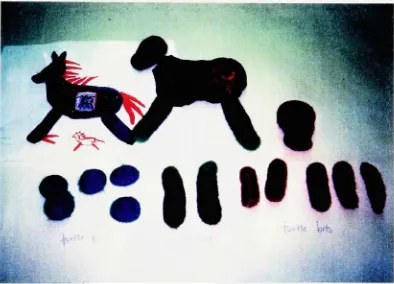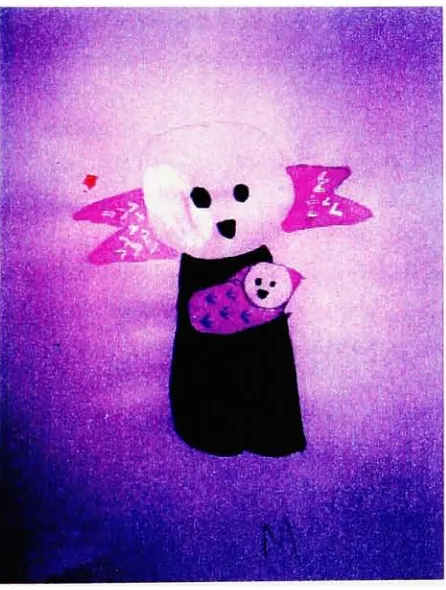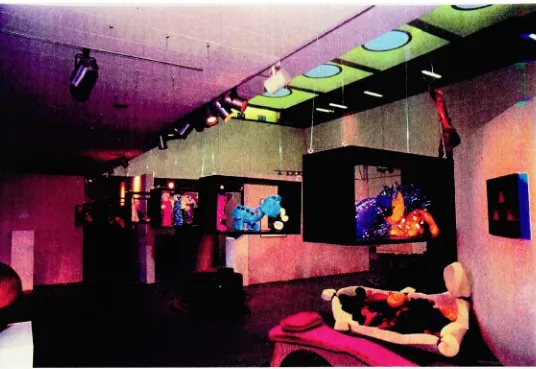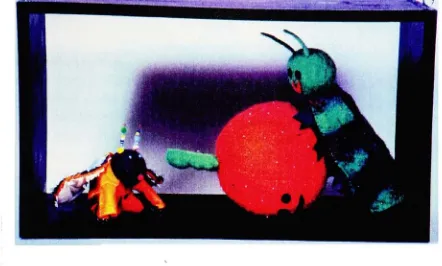Rochester Institute of Technology
RIT Scholar Works
Theses
Thesis/Dissertation Collections
5-10-1997
Alphabet fantasy
Kimberly Kllc
Follow this and additional works at:
http://scholarworks.rit.edu/theses
This Thesis is brought to you for free and open access by the Thesis/Dissertation Collections at RIT Scholar Works. It has been accepted for inclusion
in Theses by an authorized administrator of RIT Scholar Works. For more information, please contact
ritscholarworks@rit.edu
.
Recommended Citation
ROCHESTER INSTITUTE OF TECHNOLOGY
A Thesis Submitted
to the
Faculty
ofThe College
ofImaging
Arts
andSciences
In
Candidacy
for
the
Degree
ofMaster
ofFine Arts
Alphabet
Fantasy
by
Kimberly
M. Kile
Thesis Proposal for the Master of Fine Arts Degree
College of Imaging Arts and Sciences
Rochester Institute of Technology
Title: Whimsy Found on Fabric
Submitted by: Kimberly M. Kllc
Date: September 18, 1996
Thesis Committee:
Chief Adviser:
Max Lendennan
Associate Advisers: 1. Ed Miller
2. Jack Slutsky
Thesis Committee Approval:
(Signature of Chief Adviser)
_
Date:
,W
l-b?
Approval, Department Chairperson: Robert Schmitz
(signature of Department Chairperson)
_
Date:
/Ci -
:;2
-
7t;
Computer needs other than word processing:
no
Acknowledgements
Kimberly
is
deeply
gratefulto the
people whohave
supportedher
through this thesis
process.These
peoplehave
providedher
withideas,
assistance,
and encouragement.She
wouldlike
to thank
her
thesis
advisors;Max
Lenderman,
Ed
Miller,
andlack
Slutsky
for
their
enthusiasm and supportthrough the
past year.She
would alsolike
to
thank
all ofher
classmatesin
the textiles
department.
All
ofthese
peoplehave been
awonderful source of
inspiration
and encouragementfor
her.
Kimberly
wouldlike
to thank
her
parents,
Adrienne
andMichael Kile for
their
support and sense ofhumor
through this
whole process.Most
ofall,
Kimberly
wouldlike
to thank
her
partnerandfriend,
Anthony
Di
Pietro,
for
his
consistent support andfaith
during
the
past year.TABLE OF CONTENTS
Acknowledgements
Hi
List
ofIllustrations
v1.
Introduction
12.
Evolution
ofThesis
23.
Materials
andProcesses
5
4.
Properties
ofFelt
andWool
8
5.
The Thesis
Works
106.
Reactions
to the
Display
207.
Conclusion
20Bibliography
21LIST OF
ILLUSTRATIONS
1.
Painted Silk
Dress,
Front
3
2.
Painted Silk
Dress,
Back
3
3.
Palette
ofDyed
Roving
4
4.
Dyed
Roving
,4
5.
Carding
Machine
6
6.
Flat Felt
withOctopus
7
7.
Unicorn in Process
andLegs
7
8.
Prototypes
ofHorse
andCaterpillar
8
9.
Sketch
for Brother
9
10.
Sketch
for Caterpillar
9
11.
Sketch
for
Mother
9
12.
Display
15
13.
Lion
andGrey
Squirrel
1614.
Rabbit,
Elephant
,andPanda
1615.
Brother, Father, Mother,
andKitten
17
16.
Astronaut,
Valentine, Xenopus,
andIguana
17
17.
Queen
Quilter,
Turtle,
andSnowman
1818.
Octopus, Whale,
andNarwhal
1819.
Yellow
Jacket,
Jack
O'lantern,
andCaterpillar
19
20.
Unicorn
andDairy
Cow
19
Introduction
The
goal ofthis
graduatethesis
wasto
create26
smallfelt
sculptures ofanimals,
creatures,
and characters.These
characters weredesigned
to
worktogether
as onelarge
twen
ty-six
unit piece of work orin
single units or small gcoups as smaller pieces of work.The
entire
group
workstogether
because
the
name of each animal or characterbegins
with adifferent
letter
ofthe
alphabet.It
was a goalto
makethe
animals and charactersappealing
and amusing.Bright
colorswere tised as were simple
facial features
sothey
would appearfriendly.
Familiar
shapesEvolution
ofthe
Thesis
The
original plan ofthis thesis
did
notinclude
felt
characters.It
did
notinclude felt
atall.
Originally
this thesis
was aboutquilting,
cutting
andpiecing,
whichtook
long
amountsof
time.
The
technique
ofAfrican American quilting
wasstudied and explored.African American quilting is
improvisational
and whimsical.It
usesbright
colors andit
is very
free,
like
the
artwork of children.These
are all qualitiesthat
weredesired
in
the
body
of artwork .It
wasfelt
that
a yearlong
project could notbe
made of quilts withcommercial
fabric.
Another
type
ofquilting
that
had been
explored and enjoyed wasthe
Victorian
Crazy
quilts.
Crazy
quilts are alsoimprovisational
quilts.They
usedfancy
scraps offabric
that
were pieced
together to
create a myriad offancy
scrap
treasures.
The
maindifferent
characteristic of
these
quiltsis
that
they
arehighly
embellished afterthey
are pieced.They
canbe
embellished withembroidery,
buttons,
beads,
other pieces offabric,
charms,
and
many
otherfound
objects.It
is
an enjoyable process.Small
embroidered animals andpeople were often
incorporated into
the
crazy
quilts.Kimberly
's
"whimsical
characters"have been in
processfor
afew
years.Animals
andsmall people are often
drawn in ongoing
sketchbooks and onscrap
paper,
whichis
then
glued or
taped
into
the
sketchbook.The
characters arekept
there
as akind
ofwomb,
where
they
live
until a placeto
putthem
or ajob
to
givethem
is found.
Paintings
werefirst
made ofthe
characters.The
paintings were quiltlike
asthe
canvases were pieced
together
withdifferent
colors offabrics. Little
characters andtext
werethen
painted .This led
to the
idea
that
one covild wearthe
quilts withthe
charactersapplied.
At
the
beginning
ofthe thesis
researchit
was plannedthat the
characters wouldbe
paintedor printed onto cotton and silkfabric
that
wouldbe
madeinto
wearablejack
ets.
It
wasalso plannedthat the surface,
after painted withfabric
paint ordye,
wouldthen
be
embellished with patchesoffabric
and excessive embroidery.Two
different
jack
ets,
onein
cotton and onein
silk were paintedbut
neither were executed.Although
the
paintingshad
afresh exciting look
to
them,
the
paintedfabric
appearedlifeless. The
characters weren'tfun,
the
colors weredull. The images
wereforced
and contrived
instead
ofspontaneous.A
changeoftype
of silk and a change oftype
ofdye
would
have
madeadifference. A
dress
of painted silk with animals onit
waslater
madethat
wassuccessful,but
atthe time
what wastrying
to
be
achieved wasn'thappening.
An
alternativeplanfor
the thesis
project was planned.As
a result ofresearchthe
fol
lowing
characteristicswereto
be incorporated. Three dimensional
characters wereto
be
made
from
felt.
They
wereto
have
a spontaneousquality
and each wouldhave
an essenceof
its
own.The
new plan wasvery
exciting,
it
had
endless possibilities.A
decision
wasmade
to
makethe
twenty
sixcharacters,
eachfor
one ofthe
letters
ofthe
alphabet.It
wasplanned
that the
sculptures musthave
some characteristicsin
common.A
paletteofseven colorswas chosen.
(See Fig.
3,
pg.4)
Each
ofthese
characterswouldbe
one ofthe
chosen colors.
Some
ofthe
animals and characterswere madein
their
natural colors andothers were made
in
fauvist
colors.Each
ofthe
sculptures were plannedto
be
aboutthe
samesize,
between
sevenandten
inches
tall.
All
were madefrom
woolfelt. Each sculp
ture
wouldbe
embellishedin
a uniqueway
to
complimentthe
shape and color.Materials
andProcesses
Felt is
madeby
agitating
wool with water and soap.It
canbe
done
by
hand,
whichis
traditional,
orit
canbe
done
by
machine.Because
oftime available,
most ofthe
felt
made
for
this
project was madein
the
washing
machine.The
flat
felt
fabric
pieces weremade
by
making
batts
in
the carder,
a machinethat
combsthe
woolfibers
sothat
they
lay
in
the
samedirection.
(See Fig.
5,
pg.6) Three
layers
ofbatts
arelaid between
two
lay
ers of
screening,
sothat
eachlayer lays
in
the
oppositedirection
ofthe
onebeneath it.
Then
the
screenis
sewn shut andthe
screen andfibers
are sewntogether.
This is
sothe
wool won't move or escape
during
the
felting
process.The
packageis
then
runthrough
ahot
wash cyclein
awashing
machine and ahot seventy
minute cyclein
the
clothing
dryer.
This
process makes athick
andstudy
piece offelt
fabric.
(See Fig.
6,
pg.7)
Three
dimensional
shapes offelt
can alsobe
madein
the
washer anddryer. In
this
processthe
batts
are rolledup
andthen
sewnbetween
the two
layers
ofscreening,
making
surethat
an outline
is
sewnto
create a general shape.(See Fig.
7,
pg.7)
There
arethree types
of processesthat
were usedin making
these characters; the tube
shaped, the two
sidedanimal,
andthe
moldedbody
form.
They
are all successfulin
dif
ferent
ways.The
two-sided
andthe tubular
animals arefirst
madefrom
aflat
piece offelt
fabric.
The
two-sided
animals arethe
dairy
cow,
horse, lion, kitten,
andthe
unicorn.The
tubular
characters are madefrom
atube
ofsewnfelt fabric. These
arethe
family
characters,
the queen,
andthe
rabbit.The
molded characters were madeby
making
three
dimensional
pieces offelt
instead
offlat.
These
characters arethe
iguana,
panda,
snowman,
andthe
yellowjacket.
The
first
thing
that
wasdone
to
planthe
characters was alist
ofthe
letters
ofthe
alphabet
werewritten out and animals and characters werelisted
to
go with eachletter. Some
of
the
letters had many
animalsand charactersthat
went withthem
and somehad
very few.
It
wasparticularly difficult
to
find
characters oranimalsthat
began
withthe
letters
"X"and
"Y".
Preparation
of piecesbegan before
allofthe
characters were chosen.A
full
colorand
full
size plan was made ofthe
project on paperin
watercoloror gouache paints.(See
Figs.
9,
10&
11, pg.9)
The
colorfor
the
character wasdecided
andthe
embroidery
and/orbeadwork
wasdesigned. These
factors
were opento
change atany
time
in
the
process.At
times there
is
a great resemblance ofthe
pieceto the
originalsketch,
othertimes
they
arevery different.
At
this
point afirst
pattern wouldbe
made.It
was made on paper and cutout.
A mock-up
ofthe
character was madein
muslinin many
cases.(See
Fig.
8, pg
8)
Then
the
paper patternwas altered asnecessary
andlabeled.
The
unfeltedwool,
calledroving,
wasdyed in
the
six colorsthat
had been
chosen.The
seventh
color,
white,was notdyed. The
wool wasleft
asits
natural color.The
felt
wasthen
madein
the
appropriate colorsfor
each ofthe
projects.The
size ofthe
piece ofwool
before
felting
had
to
be
almosttwice the
amount offelt
neededbecause it
shrank somuch
during
the
process.In
some casesthe
felt
had
to
gothough the
washing
anddry
ing
cycletwice to
makeit
stiff enough.It
wasinteresting
to
notethat the
morefelt
there
was
going
through the
washing
machine at onetime,
the
harder
the
felt
wouldbecome.
The
flat
pieces offelt
werethen
cut outaccording
to the
paper patterns.One
gooddif
ference
between
felt
and wovenfabric is
that
felt
has
no grain.Therefore
pattern piecescan
be
laid
out atany
angle,
and space canbe
usedto
a maximum.The
pieces,
flat
andmolded were
then
embellished withthe
facial
features
andthe
decoration.
The
sculpturemade with
two
sides or madefrom
atube
werethen
sewntogether.
The
appendages andhead
werethen
sewnto the
body.
[image:12.567.163.408.342.517.2]Figure
6.
A
piece offlat felt
and an octopus.Figure
7.Legs
andheads
were often made [image:13.567.82.489.7.286.2] [image:13.567.84.478.346.630.2]Properties
ofFelt
andWool
Felt is
truly
anamazing
fabric.
It
has
many
wonderful qualities andit
has many
uses.It
is
madein many
places aroundthe world,
notonly for
dolls
andart,
but
for
clothing
andliving
structures.Felt
will not ravelorfray
like
wovenfabrics.
Felt
canbe
madein any
size,
unlikethe
way
that the
sizeofaloom
restrictsthe
size of a woven piece offabric.
If
a piece offelt fabric
is
notbig
enoughit
can evenbe
added onto.
It
canbe
madesoftor
hard,
dense
orthin.
Felt is very
durable
and protective and even whenit
does
wearthe
felt
underneaththe
exterioris just
asdurable.
Felt
is
anamazing insulator
for
warmthand
sound, therefore
it is
usedto
line clothing
andfor
piecesin
musicalinstruments like
pianos and
drums.
Because it is
such a protective materialit is
usedby
Central Asian
people
to
maketents that
are calledYurts.1Wool is
the
main materialthat
is
usedin
felting
because it
reacts wellto the
process.Wool
fibers
are covered with scales whichlook remarkably like
the
scales on afish. These
scales open
up
andlatch
together
whenmoisture,
heat,
andagitation are addedto the
wool/Some
scales pointin
onedirection
andothersin
the opposite, this
makesit easy for
them
to
latch
together.
Friction
is
made and more entanglementhappens,
this
is
calledthe
Directional
Fiber
Effect.'Figure
8.
These
werethe
first horse
andcaterpillarmade.Making
these
two
prototypeswas a signthat this
projecthad
potential.Beverly
Cordon.1-eltnKikini;: Walson-GuplilI Publications,19S0,p.8Beverly
Gordon. Feltmuking: Watson-Guptill Publications, 1980,p.8.Beverly
Gordon. Feltmaking:Watson-Guptill Publications, 1980,p. 9. [image:14.567.104.467.401.644.2]Figure
9.Gouache
and watercolorstudy for "Brother".
Figure
10.Gouache
andwatercolorstudy for "Caterpillar".
Figure
11.Gouache
and watercolor [image:15.567.31.258.15.307.2] [image:15.567.318.538.184.470.2] [image:15.567.35.258.383.678.2]The Thesis Works
Astronaut. This
characterwasnotthe
first
onethat
wasdesigned. The
characters werenot made
in
the
order ofthe
alphabet.He
is
atall
whitedoll.
He
has
a round whitehel
met and sequin stars on
his
space suit.He is imaged
afterone ofthe
quicksketchesfound
in
the
sketchbook.Brother. This
character wasimaged
afterthe
artist's ownbrother. The image
offamily
is important
to
her
andhas
oftenbeen depicted in
the
past.The
three
charactersthat
make
up
the
artist'sfamily
aredisplayed
together.
He
is
tall
and slender and enjoysunusual clothing.
This
is why
the
bright
plastic stars onhis clothing
are appropriate.They
may be
consideredtacky,
but
they
fit
the
personality
ofthe
brother
andtherefore
they
fit
the
doll.
Caterpillar. This
caterpillar wasthe
first
characterdesigned for
this
project.It began
asa watercolor
painting
that
was consideredtoo
preciousto
notkeep.
The
making
ofthe
felt for
this
caterpillar wasinteresting
because it
was madefrom
two
different
colors ofwool so
that
it
has
stripes.It
alsohas
a materialcalled coconutfiber
that
wasfelted into it
to
giveit
ahairy
feel.
He
has little
caterpillar claws.Dairy
Cow. The
artisthas
alwaysbeen
attractedto
cows.They
are quiet and peacefulanimals.
The
spots are of particularinterest,
embellishedwithbeads surrounding
eachspot.She
was one ofthe the
early
characters.It
is
interesting
that the
earliercharactershave
atighter
quality
to them.
The
worksloosened up
andbecame freer
asthe
project went on.Elephant. Elephant
images
arepopular.They
are afun
animalto
image.
This
elephantis decorated in
circus colors.He
is
embellishedwithsmalltubularbeads
andlarge
roundflat
sequins.The felt
is
turquoise.
The
ears are quilted andthey
aresolarge
that
they
flop
down
overthe
face.
Father.
This image
ofthe
father is
atypical
ofthe
artist.He
is
long,
tall,
and wears a mustache.He
wearsafedora
asif
he is going
to
orcoming from
work.Instead
of armshe
has
wingson either side ofhis body.
It
wasimportant
to
givethe
parents wingslike
angels
because
they
arethe
ultimateprotectors.The beadwork is
inspired
by
African
dolls. Some
ofthese
dolls
arecompletely
coveredwithtiny
beads. The
dolls
arecunning
as wellas precious.Grey
Squirrel.
Grey
squirrelis
alot
offun.
He
has
two
pearlteeth
for
a mouth.He
is
decorated
with more pearls and silver charms onhis front.
These
include;
a cat'shead,
asewing
machine,afeather,
and aring
ofkeys.
blorse. The
greenhorse
wasthe
first
ofthe
animalsto
be
completed.It
wasinspired
by
the
artist'sbrother's
paper machehorses,
one of which was"Lime
Pony". This "Lime
Pony"
was also
decorated
with sequins.Making
a"Lime
Pony"
was also a
way
to
honor
the
work ofthe
artist'sbrother. The
greenhorse is subtly
decorated
comparedto the
later
animals.
The
doll
alsohas
atighter
feel
asthe
animals and charactersbecame freer
andlooser
asthe
project progressed.Iguana. Iguana
has
aflat face.
He
is
anidealized
animal.He
has
avery
long
tail.
He
has
limited
embellishment,but
on one side a castle was embroidered.Jack
O'Lantern. This is
another ofthe
early
works.It
is
a round pumpkin with a smallsimple
face.
It
works muchbetter in
the
display
that
onits
own.Kitten.
Having
afamily
catis important. This is
afat
red cat.The embroidery is
tradi
tional to
American
Crazy
quilts.The embroidery
stichis
calledfeather
stich.The
smallround sequins repeat
the
round shape ofthe
cat.Lion. Viewers
have been very
receptiveto this
animal.He
has
alarge flat
roundface,
which
is
bordered
with a mane ofblue
raffia.The
body,
head,
andlegs
are all orange.The
two
sides are covered withdifferent buttons
and afew
smallfound
objects such as asmall plastic angel and a
friendship
pin.The
facial features
are also madefrom buttons.
The
mouthis
a medium sizedblack
velvet round coveredbutton. It
mimicsthe
openmouthed roar of a real
lion.
Mother. This
piece was madespecifically
to
be
shown withthe
Father
doll. She
has
apurple
body
and sheis
embellished withthe
sameAfrican
influenced
beadwork
asthe
Father. She
has
alarge
head
and she wears abow. This is
to
giveher
afeminine look.
She
sports
the
sametype
of wings asFather
exceptthese
comefrom her head instead
ofher
body. She
has
ababy
attachedto
her front
asif
sheis
holding
her. The
baby
is
madefrom
the
same purplefelt
andhas
the
sametype
ofbeadwork. It is
obviousthat the two
arecut
from
the
same cloth.Narwhal.
Narwhal
is
asmall whalethat
has
along
horn
muchlike
a unicorns.It
has
along
sleekbody
and spots.This
narwhaldoll
was madeto
look
graceful,
eventhough
he
is.
out of water.The
spots were madeby
crosscutting into
multicoloredfelt balls.
Octopus. Octopus
is
atruly
fun
character.He
is
madefrom
one orangefelt ball
that
is
the
head
and eight rollsfor
tentacles.
The
legs
aredecorated
withbright blue
sequinswhich represent
the
suction cups.The
end of eachtentacles
is
adorned with atiny
redjingle
bell,
sohe jingles
whenhe is
picked up.Another
redjingle
bell is in
the
place ofhis
mouth.Panda. This is
avery feminine
panda.She is
madefrom
two
balls
offelt
sewntogether,
then
small roundbits
offelt
were addedfor
ears, paws,
andthe
tail.
Embroidered flowers
adorn
her
ear andbelly.
She
has
avery feminine face. Her
eyes were madefrom
smalldonut
shapedbeads
that
work wellasthe
dark
area around realpandas'
eyes.
Queen Quilter. Queen Quilter is
a proud quilter.She holds up
alittle
quiltthat
shehas
made.
She
alsohas
abeautiful
little felt
crownthat
is
embellished with sequins.Rabbit. This
rabbit reminds one of atoy
rabbit.He
sitsup
strait andhas
button
eyes.He
is
red with purple ears.He
is
avery
staticrabbit,
his legs
are so shortthat
he
couldnot move.
Snowman. This
snowman wasdrawn
as a quick sketchin
asketchbook,
wherehe
stayed until
he
was madefor
this
project.He
is
small and precious.He
is simply
madefrom sewing
three
felt balls together,
with arms andthe
base
added.He
is
embellishedwith pieces of commercial
fabric
ofsnowflakes.The
snowflakes werecarefully
appliedwith a
blanket
stitch.This
representsthat the
snowmanis actually
madeup
ofsnowflakes.
Turtle. The
turtle
has
a green shell and redappendages.His
back has five
turquoisetiles
on
it
which are each adornedwithdifferent
beads
andbuttons in
pinks and reds.One
ofthe
mostinteresting
things
aboutthe turtle
is
that
whenthe
felt
was madefor
the
head
acrease ofscreen was caught
in it
and made a perfectlittle
spacefor
a mouth.It
could nothave been
plannedbetter.
Unicorn.
This
unicornis built very similarly
to the
horse. She is
purple with along
mane and
tail.
She
has
patches ofbrightly
coloredcommercialfabric
on eitherside withpictures of children.
She
has
along
singlehorn
madefrom
copper wire.Valentine.
This
was madebecause
an animalstarting
withthe
letter
"V"wasdifficult
to
come
up
with.It
is
a stuffed redheart,
embellished withembroidery
andbeads.
It
bears
the
words"Be
Mine".
Whale.
This
whaleis inspired
afterresearchon avery large
whale calledthe
Blue Whale.
He is
long
and turquoise.He
is simply
embellished andhas
small gold sequinsfor barnacles.
Xenopus. A Xenopus
is
a species ofAfrican
frog. It
was madein
orange withbright
spotsand sequineyes.
Yellow
Jacket.
This is
aninventive
yellowjacket.
He
is
aflying
insect
who wears a smallfelt
yellowjacket.
His
wings are makefrom layered
commercialfelt
and silk.His
antennae and
facial features
are wiredtiny
pompons andbeads.
Zebra.
The
zebrais
anotherhorselike
character.He
is
madefrom
whitefelt
andhas
redstripes made
from
ribbons and mohair.The
maneis
madefrom
red mohair.He
looks
like he
is
relatedto the
otherhorse
characters.The
characters were all madebefore
the
method ofdisplay
was considered.After
careful
research andthought,
a method ofboxes
suspendedfrom
the
ceiling
wasdevised.
The
eight
black
woodenboxes
werehung
onebehind
the
other at eyelevel,
with enoughspace
for
the
viewerto
walkbetween
them.
The
boxes had
nofront
orback,
sothe
characters could
be
viewedfrom front
andback,
they
wereten
inches
deep,
twelve
inches
high,
andtwenty
inches
long.
The
charactersin
the
box
beyond
couldbe
viewed as well.There
were atotal
of eightboxes.
Either two,
three
orfour
characters could existin
each space.
"Alphabet
Fantasy"was
the
name givento the
work.(See Fig.
12,
pg.15)
The
first
box
holds
the
lion
andthe
grey
squirrel.They
were setup
to
look
asthough
the
lion is engaging in play
whilethe
squirrelis
trying
to
make conversation.The
two
animals
face
each other.It
was a goalto
setup
the
charactersin
situations wherethey
would
interact
with each other.(See Fig.
13,
pg.16)
The
secondbox
showsthe rabbit, elephant,
and panda.The
rabbitis in
atilted
positionon one
side,
asif
he
is is
fooling
around.The
elephant and pandaignore
the
foolishness
as
they
arehaving
their
own conversation.(See Fig.
14,
pg. 16)The
nextbox
has
personalmeaning for
the
artist.The
three
characters onthe
left
arethe
artist'sfamily;
brother,
father
and mother.The
artisthas
made mimerousimages
ofthese three
peoplebecause
they
areimportant
to
her.
She
is included in
the
image
asthe
infant
that the
motherfigure holds.
The
kitten is
alsoimportant
asthe
family
has
alwayskept
cats and are considered part ofthe
family.
(See
Fig.
15,
pg.17)
The
following
box
shows an astronautdoll,
the valentine, the
Xenopus
frog,
andthe
iguana. The
astronaut standsto the
left,
looking
surprised.It
is for
goodreason,
for
the
Xenopus
is presenting
the
valentineto
him.
The
iguana is
not visibleto the
viewer untilthe
back
ofthe
box is
seen.The
iguana
staysto the
side and watches.(See Fig.
16,
pg.17)
The
queen quilter shows offher handmade
quiltin
the
nextbox. She leans
forward
to
show off
her handiwork. The
turtle
leans in
to
get abetter look
andthe
snowman raiseshis
armsin
astonishment.(See
Fig.
17,
pg.18)
The
sixthbox
shows an assortment of sea creatures.The
whale, the octopus,
andthe
narwhal all
occupy
this
space.(See
Fig.
18,
pg.18)
The
seventhbox is
afun
situation.The
caterpillaris
trying
to
rollthe
jack
o'lantern,
but
it
is
too
heavy. The
yellowjacket
watches.(See
Fig.
19,
pg. 19)The
last box is
asampling
ofthe
horse
and all ofthe
animals relatedto the
horse.
The
cow, the zebra,
andthe
unicorn are allhere. The
cow andthe
unicorn are onthe
front
side of
the
box,
leaning
in
towards
each other.The
zebra andthe
horse
touch
noses onthe
back
side ofthe
box.
(See
Fig.
20,
pg.19)
Figure
12.Boxes
hung
for display.
[image:21.567.17.553.61.430.2]Figure
13.Lion
andGrey
Squirrel.
Figure
14.Rabbit,
Elephant,
andPanda.
[image:22.567.77.501.15.280.2] [image:22.567.61.476.377.651.2]Figure
15.Brother,
Father,
Mother,
andKitten.
[image:23.567.64.509.33.296.2] [image:23.567.63.510.369.664.2]Figure
17.Queen
Quilter,
Turtle,
andSnowman.
Figure
18.Octopus,
Whale,
andNarwhal.
[image:24.567.58.511.24.305.2] [image:24.567.66.515.338.657.2]Figure
19.Yellow
Jacket,
Jack
O'lantern,
andCaterpilla
:U.Figure
20.Dairy
Cow
andUnicorn.
The Horse
andZebra
are seen onthe
back
side ofthe
box.
[image:25.567.63.505.29.295.2] [image:25.567.66.503.355.661.2]Reactions
to
the
Display
The
reactionsfrom
the
viewers provedthat this
installation
was successful.Viewers
laughed
whileviewing
the
pieces.Some
viewers wishedto touch
andhold
the
characters.Others
wantedto
own one.Some
ofthe
viewers wereinspired. One
particular writtenreaction
by
a viewer was asfollows.
"Kim,
congratulations!It
made mevery
happy
to
seeallof your attractive works.
You
have
shown methe
possibilities offelting
for
dolls
aswell as sculpture.
I
appreciateall of yourworks."
The
main goal ofthe thesis
wasto
entertainthe
viewer withlittle
animals andcharacters.The
characters weredisplayed
in
groupsfor
this thesis
exhibitionbut
they
alsomay be
displayed
out ofboxes,
in
othergroups,
or ontheir
own.During
the
setup
ofthis
showdifferent
characters were placedamong
other artworkin
the gallery,
hiding
around orsneaking
nearthe
pieces.Photos
weretaken
for
researchfor
another possibledisplay.
Conclusion
There
aremany
projectsin
the
early planning
stagesfor
the
characters of"Alphabet
Fantasy". An
article aboutfeltmaking
anddollmaking
is going
to
be
writtenand submitted
to
afiber
art magazine.Two
books
arebeing
thought about, the
first is
afeltmaking
anddollmaking
instruction
book
andthe
secondis
a children's alphabetbook
with photographs of
the
charactersfrom "Alphabet
Fantasy"
in different
situations.It
is
also
being
plannedto
make copies ofthese
charactersto
sell.There is
a concern aboutmaking
too
many
ofthem
because
the
quality
ofthe
craftsmanship
must notbe lost.
New
anddifferent
characters willalsobe
createdfor future
projects.The
time
spentworking
onthis thesis
projecthas been
anexciting
andchallenging
period.
Designing
andcreating
these
charactershas
been
ajoyful
and playful process.There
willbe many
projectsthat
willinvolve felt
charactersin
the
future. The
possibilities
ofthe
conceptsoffelt making
areexciting
andlimitless.
Bibliography
Bradshaw-Smith,
Gillian. Adventures in Toy-Making. New York:
Taplinger
Publishing
Company,
1976.
Burkett,
M.E.. Art
ofthe
Felt Makers.
Kendal
Cumbria: Abbot Hall Art
Gallery,
1979.
Gordon,
Beverly. Feltmaking. New York: Watson-Guptill
Publications,
1980.
Laury,
Jean
Ray. Doll
Making: A Creative
Approach. New York: Vin Nostrand
Company,
1970.
Spark,
Patricia. Fundamentals
ofFeltmaking. Coupeville,WA: Shuttle
Craft
Books,
1989.
Spark,
Patricia.
Scandinavian-Style
Feltmaking.
Coupeville,
WA:
Shuttle
Craft
Books,
1992.
Figure
21.The
artist withthe
snowman. [image:28.567.111.461.66.572.2]








